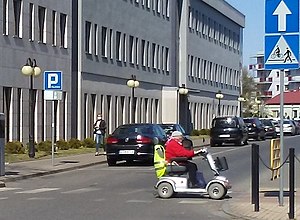Geography of disability
Potential components of studies in a geographical analysis include the environment, politics, incidental and additional supports, and the socio-economic landscape of the region being examined.
[2] The WHO report indicates that poverty, government investment in medical services, and individual access to health care impact disability rates in developed regions.
[3] During the late 20th century, geographers and sociologists began to adapt the field's understanding of disability from a medical point of view towards a socio-spatial determinant.
[4] In 1972, the Union of the Physically Impaired Against Segregation was formed by Lancastrian disability-rights advocate Paul Hunt and the South African writer and activist Vic Finkelstein in the wake of their struggles to remain independent adults while relying on social programmes to provide essential healthcare services.
[6] With other nascent sociopolitical movements such as third-wave feminism and environmental justice in the early decades of the 21st century, geographical studies of disability have begun to examine the relationship between disability as a function of socioeconomic status (given the racialization of poverty in many Western nations) and physical, mental, and developmental diagnoses in areas with severe air or water pollution, or poor access to food and housing.
These observations suggest that using particular qualitative or interpretative methods is a preferred way of giving voice to disabled people's experiences and opening up the scope for inclusive research practices.
In this respect, some important methodological developments in geographical research seek to articulate the different ways that disabled people know and experience the world.
[11] Public-health professionals recognize the need for supportive programs, but may be incentivized by governmental administration or local legislatures to reduce budget costs by weakening services.
Poorer urban areas lack the resources to fight illegal pollution, unfair housing practices, and other detrimental community policies whicht may disproportionately impact them.
During the early 2000s, longitudinal data on the incidence of noninfectious diseases began to indicate the interaction between residence and the risk of developing special healthcare needs or disabilities later in life.
[23] Harris County, Texas, which includes Greater Houston, needs 75 additional psychiatrists to meet the minimum required ratio of providers to patients in need.
Without access to a provider of a diagnosis, patients may not be able to show required documentation to the state or federal agencies who are gatekeepers to social-welfare entitlement programs such as Medicaid and Social Security Disability Insurance.
Given the broad spectrum of physical, emotional, and social capabilities, urban planners and civil engineers have begun to shift design practices for public spaces to incorporate more stakeholder feedback from affected persons or invite discussion on behalf of them.
For example, an adult with severe cerebral palsy may be nonverbal and rely on a wheelchair for mobility; carers, family, and friends can provide feedback on private and public projects to best accommodate them.
This research has presented disability as a population characteristic that inevitably leads to marginalization and spatial exclusion from otherwise normal social arenas and spaces within the built environment.
Disabled individuals face a wide range of harassment in different settings, "Harassment, name-calling and sometimes violence on streets, in shopping areas and parks, and in local neighbourhoods; harassment near, and damage to, people’s homes, access ramps, gardens and adapted cars; being shouted at and victimised for use of disabled parking spaces at shopping centres and for occupying wheelchair spaces on public transport; verbal abuse and being pushed past in shops, cafes and pubs; abuse in online spaces; being taunted outside care facilities; and abuse, violence and exploitation within institutional care, day centres and individuals’ homes"[31] A survey was conducted where individuals who experienced hate crime were asked where bad things happen, "In Medway, Kent (SE England), people with learning disabilities described the following as “where bad things happen”: school, college or day centre (43%); in the street as they were walking somewhere (35%); in and around their home (28%); in their neighbourhood (28%); and on public transport (25%)"[31] Another study by McClimens et al. in 2014 found that people with learning disabilities had fear about their personal safety which shaped the way they Sheffield city centre, "Similarly, a study by McClimens et al. (2014) found that fears about personal safety shaped people with learning disabilities’ use of Sheffield city centre: certain places (e.g., near a homeless shelter), certain people (e.g., those begging for money) and certain times (e.g., after dark) made people fearful.
Pain concludes that fear of crime is “an extension of the discrimination and, in some cases, harassment which disabled people may face using urban spaces in everyday life” (1997, p. 241).
There are possibilities to reshape the way disability hate crime is addressed and looked at, "reshape the ways in which the police and local authority agencies interpret and address hate crime, from the current focus on increasing reporting of incidents and prosecutions to prevention strategies, to identify and intervene in spaces and relations where hostility is likely to emerge.
